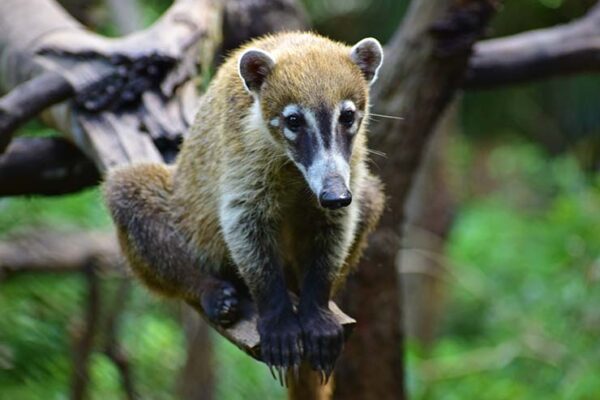
Biology
Tail length: 11 inches
Weight: 3.3 lbs
Lifespan: 7-14 years
Average # of offspring: 4-6
Gestation: 77 days
Range & Habitat
Habitats: Tropical forests; mountains; woodlands; grasslands; riparian forests
Food & Function
Lifestyle: Diurnal, Terrestrial, Arboreal, Territorial
Ecological Roles: Pollinator, Prey species.
Coatimundi
(Nasua narica)
Spanish: Pizote. Belizean Creole: Quash
The coatimundi is a member of the Procyonidae family, related to kinkajous and racoons. Similarly, coatis have long pointed snouts and tails that are nearly half the size of their body length. Coatis use their snouts to sniff the forest floor for food and their semi-prehensile tail to keep them balanced when climbing trees.
Coatis live in groups called bands or troops consisting of 3 to 20 members; with most of them being adult females and their young. At age 3, male coatis become sexually mature and abandon their troop. From there on, they become solitary. Only one male is allowed into the troop at a time during mating season. After being accepted, the male will mate with all the members of the troop and then will be driven away.
Fun Facts
- Males are driven out after mating due to the possibility of them commiting infanticide within the troop.
- All the female coatis in a troop help to protect each other’s young.
- A coatimundi’s ankles rotate 180 degrees, enabling it to climb down a tree head first
- Coatis are important prey for predators like jaguars, pumas, eagles, and boas
Belize Zoo Trivia
- Many of the coatis in the Zoo are former pets that were confiscated or simply surrendered by frustrated families who tried to “tame” them. Coatis are always wild, and never make good pets!
- They love to climb in their “jungle gym,” using ropes and tree trunks to move up and down their habitat
- Coatis love new and interesting smells, so our staff provide enrichment in the form of objects sprayed with “coati-friendly” scents and perfumes
